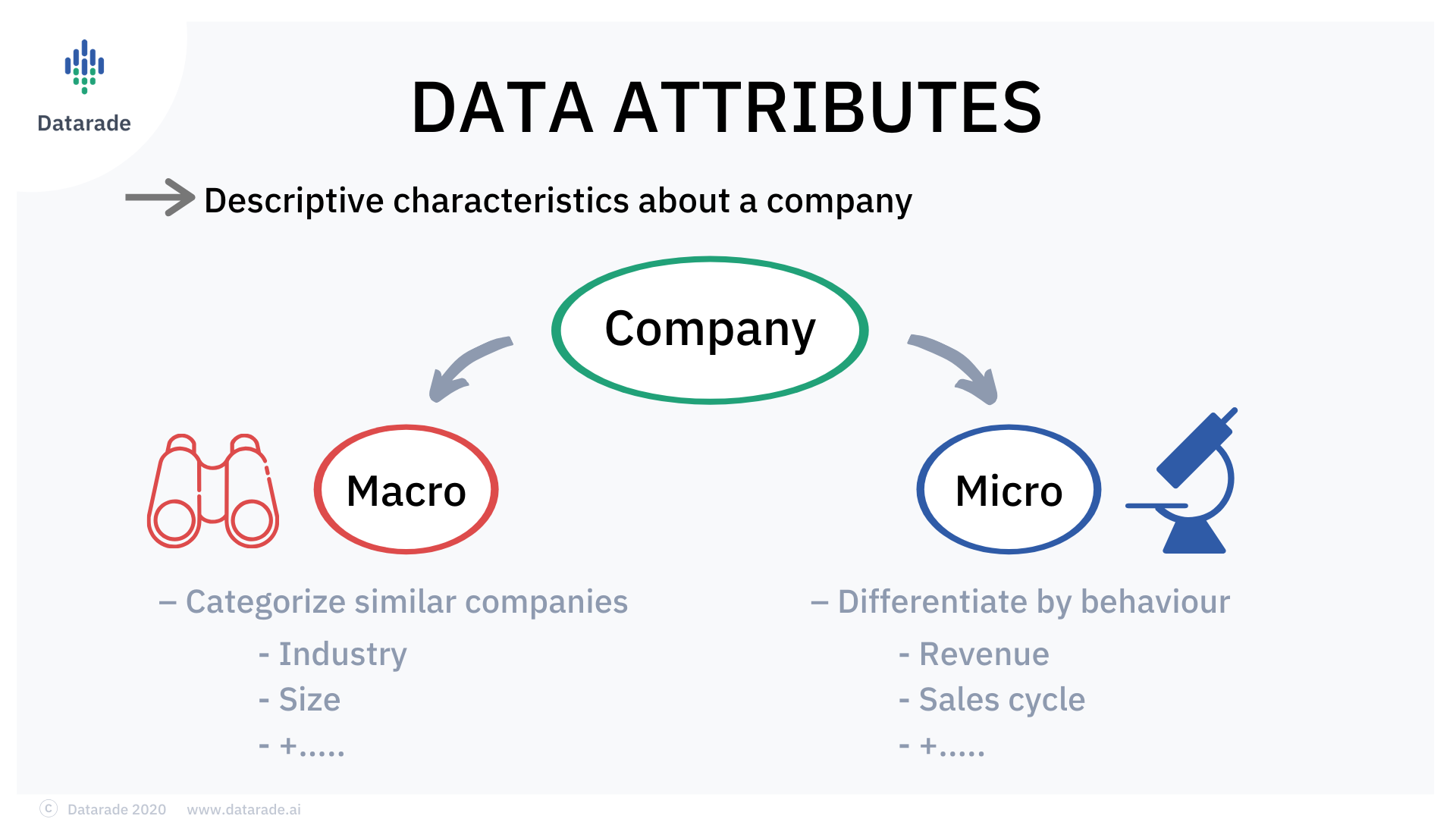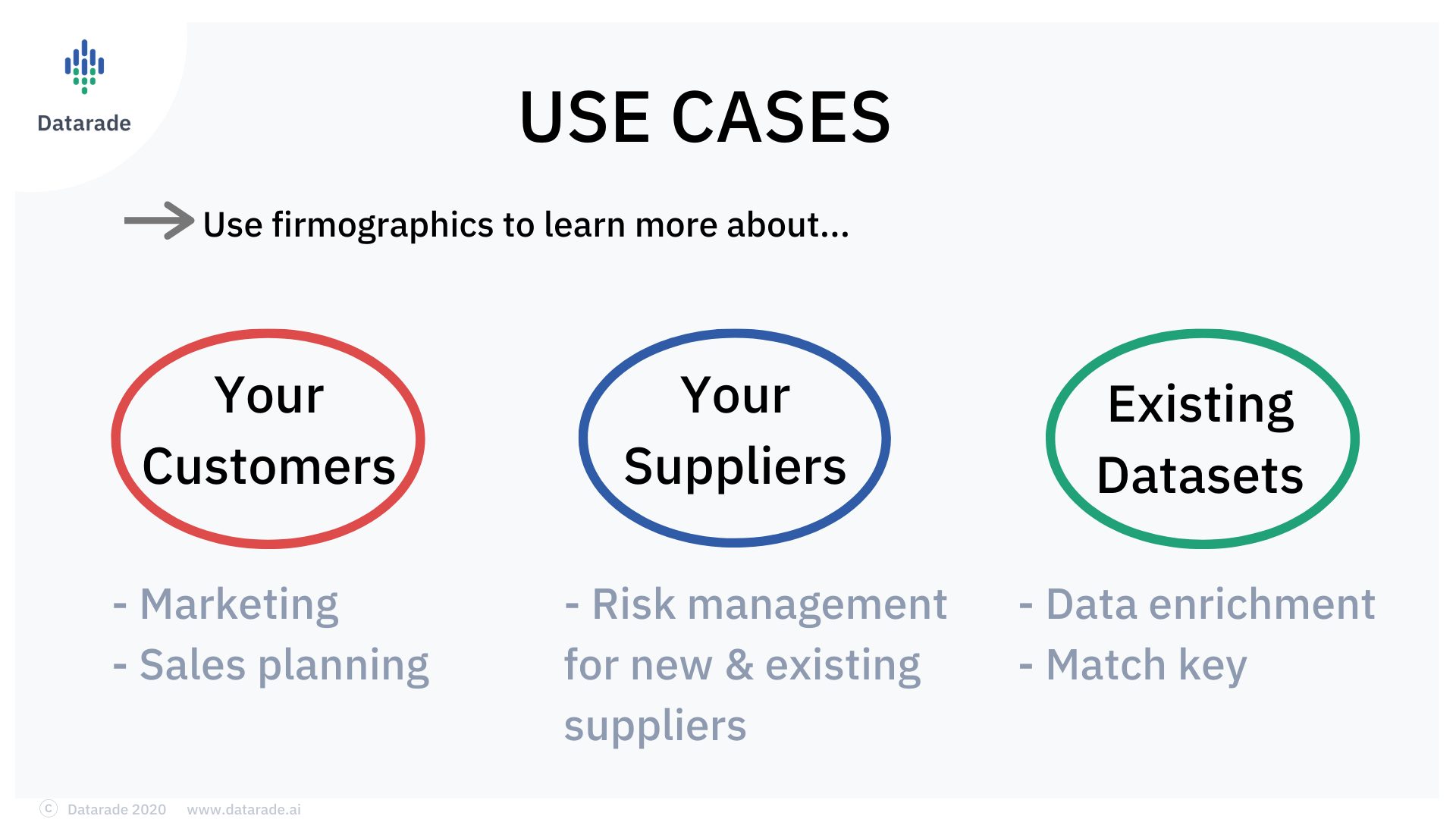What is Firmographic Data? Uses, Types & Dataset Examples
What is Firmographic Data?
Firmographic data refers to demographic information about a company or organization. It includes characteristics such as industry, company size, location, revenue, and number of employees. This data helps businesses understand their target market, identify potential customers, and make informed decisions regarding sales, marketing, and business strategies.
Best Firmographic Data Databases & Datasets
Here is Datarade's curated selection of top Firmographic Data. These trusted databases and datasets offer high-quality, up-to-date information.
MixRank - US Only Company Dataset | 7M+ Records | 5M Updates/Month | Hourly Delivery via CSV/JSON/PostgreSQL Database Delivery
Bright Data | Business Firmographic Data
BRIDGE | Firmographic Data | US Business | Top Ranked | B2B Marketing Data | Get the best Firmographic Data
Versium REACH - Firmographic Append, B2B, USA, CCPA Compliant
Global Wineries, Distilleries, and Breweries Firmographic Data: 330,000+ Detailed Company & Contact Data, Targeted Marketing
Company Data | Firmographic Data | 16+ Industry Segmentation | Global Coverage | 100M+ Contacts | (Verified E-mail, Direct Dails)| 20+ Attributes
Xtract.io | Firmographic data | Company data | B2B data
Grepsr | Company Data | Firmographic Dataset | B2B Data | Global Coverage with Custom and On-demand Datasets
Firmographic Data on all 300 million businesses worldwide in single Dataset
Firmographic Data for all Businesses in Denmark ( 916,000 Businesses )
Top Firmographic Data Providers & Companies
The primary selection criteria for firmographic data providers should revolve around the accuracy, comprehensiveness, and currency of the business information offered, ensuring it aligns with the specific profiling needs of the organization.
Popular Use Cases
Firmographic Data plays a pivotal role in various business applications, offering valuable insights and opportunities across industries.
Firmographic Data Explained
Attributes of firmographic data
Firmographic data consists of all the characteristics that can be used to describe and categorize a business. These can be on a macro scale, like size and industry, or on a micro scale like revenue and sales cycle length.

(Click image to enlarge)
Some of the key attributes of firmographic data include:
- The legal status of the company (publicly owned, privately owned, non-profit, NGO, Inc., LLC.)
- The location of the various branches of the company (region, country, state, city, zip code, address)
- The company’s industry (SIC classification codes)
- Company size (including revenue, number of employees, SME)
- Performance (sales cycle length, sales numbers, quarterly and annual profits, credit rating)
- Company structure (headquarters, parent companies, subsidiaries)
As you can see, firmographic data really provides a comprehensive description of every aspect that it might be beneficial to know about a company.
What’s important for you is to identify which attributes will be of most use for you depending on the type of business you’re interacting with. Businesses can each have their own unique style: a Fortune 500 company will not operate in the same way as a small, young start up.
Sources of firmographic data
The majority of firmographic data sources are publicly available, being things like company websites, company registers, tax declarations, and white paper reports. This is because when a company is created, it must often provide the legal body of its country of operation with basic firmographic information like its legal status, address, and annual revenue.
However, some crucial firmographic information, like that which is not required to be shown by law or for companies based in untransparent countries, is much harder to access. Indeed, sourcing even just basic
firmographics yourself can take up a lot of time and resources, and that’s not accounting for these difficult cases.
Because of this, most companies will turn to data providers to collect and present the firmographic data for them. In many cases, even large firmographics firms will use data from smaller companies to bolster their own available information!
Use Cases
The point of firmographics is to know more about companies. Thus, the main use case for firmographic data is knowing more about the different organizations you’re involved with, from future prospects, to your current customers and suppliers. This can help you to check that your company is only engaging with the right firms and that you engage with these firms properly.

(Click image to enlarge)
Firmographic data can be crucial for the personalization of content. It can be used to formulate the following factors, creating advertisements in social media targeting a sector, creating effective blog posts to influence the market, creating newsletters and email campaigns for companies, A/B testing, creation of study materials and tutorials for a specific company.
However, all of this is done within the context of if the company is a potential prospect, a current client, or an existing supplier.
Here is a list of how the use cases of firmographic data fit into your understanding of all the companies you’re involved with:
Understanding Your Current Customers
It goes without saying that it helps to know the companies that are currently purchasing your products/services. While you may already have a pre-established relationship and a decent idea of who and what they are, firmographic data can fill in gaps and help with useful predictions.
For example, you may not know that a current customer company has recently increased its number of employees by a substantial amount. Firmographic data can find this out for you as soon as it is happening and without you even needing to ask. by looking at which departments the company is growing in, you can determine if you’ll need to adjust your categorization of this customer and if perhaps you could upsell them more of your products.
Evaluating Your Existing Suppliers
An often unconsidered benefit to firmographic data is that it can also help you to evaluate the performance, and thereby the value, of your existing suppliers. You can’t even begin to satisfy customers and generate profit if the foundational supply for your company is rotten.
By using firmographics, you can check changes to the size, performance, and revenue of your existing suppliers, letting you know if they’re good to keep or if it’s time to find a new source.
Assessing Future Prospects
The most obvious use case for firmographic data is how it can be used to judge potential companies that you might want to engage with in the future. This could be both new customers and new suppliers.
An example of using firmographics here is to categorize and segment potential prospects by firmographic attributes, e.g. country, industry, and size. You can then further differentiate them by how they behave, as shown by their revenue and sales cycle length.
This information will allow you to only engage with companies in the market you’re interested in (shown by location and industry) and who could afford your product/service (shown by budget, size, revenue). You’ll also gain an idea of how the interaction with the company will go by understanding its size and sales cycle length.
Thus, it’s very clear how acquiring firmographics is a must if you’re looking to create appropriate and reliable future B2B relationships.
Data Enrichment
Despite having uses of its own (as mentioned above), a use case of firmographics that cannot be overlooked is how valuable it is when enriching other data sets. Indeed, by using firmographics to enrich existing data, you can make its own use cases stronger.
Firmographic data is often used to enrich other B2B data types, likeintent data, B2B contact data or technographic data.
To use these data types in an example, you might have already acquired technographic data and implemented it to find a company that has a technology stack which has a gap that your product can fill. Intent data can then show you when this company is looking to fill the gap, and B2B contact data can ensure you reach the right person within that company. Now you can use firmographic data to learn more about how the company works and how the sales process will unfold, including information like its revenue and sales cycle length.
Now in order to undergo this valuable enrichment process, you the firmographic data must have a match key that can connect it with similar data points in your existing data sets. Make sure there is a match key and that this is suitable for your existing data sets, and you’re good to go.
Pricing
The pricing models for firmographic data largely depend on the vendors and the clients. In general, you can buy firmographic data as a subscription, per company, or in batches, with the price dependent on how much data is being requested.
The pricing can also be influenced by the type of the industry, size of the companies, location clusters and the niches that are being targeted by the client. This is because acquiring data for certain industries or places may be more difficult than in others.
Before you commit to investing on a pricing model, you should ask for a data sample to assess the validity, the quality, and the impact it can have for your intended use case. Most major data providers will be happy to provide a data sample.
Frequently Asked Questions
Where can I buy Firmographic Data?
Data providers and vendors listed on Datarade sell Firmographic Data products and samples. Popular Firmographic Data products and datasets available on our platform are MixRank - US Only Company Dataset | 7M+ Records | 5M Updates/Month | Hourly Delivery via CSV/JSON/PostgreSQL Database Delivery by MixRank, Bright Data | Business Firmographic Data by Bright Data, and BRIDGE | Firmographic Data | US Business | Top Ranked | B2B Marketing Data | Get the best Firmographic Data by Bridge.
How can I get Firmographic Data?
You can get Firmographic Data via a range of delivery methods - the right one for you depends on your use case. For example, historical Firmographic Data is usually available to download in bulk and delivered using an S3 bucket. On the other hand, if your use case is time-critical, you can buy real-time Firmographic Data APIs, feeds and streams to download the most up-to-date intelligence.
What are similar data types to Firmographic Data?
Firmographic Data is similar to B2B Leads Data, Technographic Data, B2B Intent Data, Company Data, and B2B Marketing Data. These data categories are commonly used for Account-Based Marketing (ABM) and Data Onboarding.
What are the most common use cases for Firmographic Data?
The top use cases for Firmographic Data are Account-Based Marketing (ABM), Data Onboarding, and CRM Onboarding.















